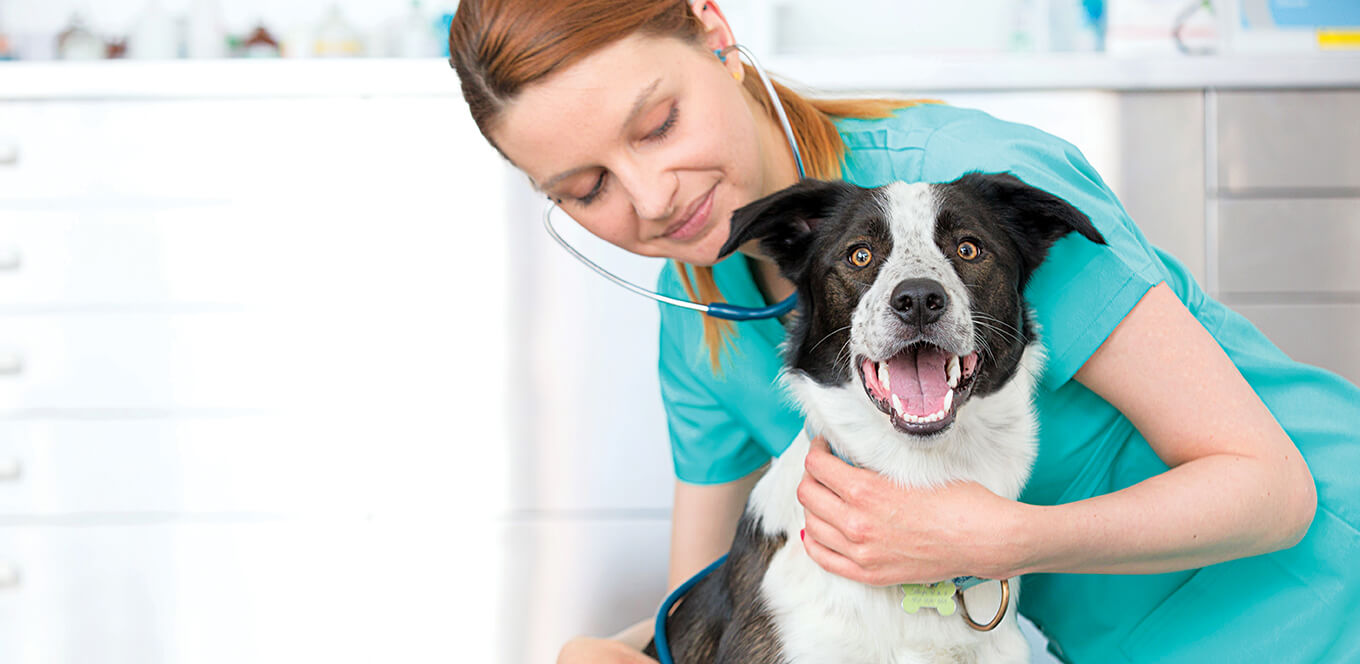

Have you ever noticed that your dog isn’t always the best at letting you know how they’re feeling, health-wise? Sure, that wagging tail tells you they’re happy, but what does it mean when they start sleeping longer, or not at all? What if they seem less interested in their food, or more interested in water?
These are the kinds of questions your vet can answer at your dog’s annual vet visits. Plus, routine vet care is the best method for preventing health problems in your dog before they arise. To help you and your dog get the most out of your next annual visit, we’re answering some common questions about checkups.
Our friends at Banfield Pet Hospital recommend partnering with your veterinarian to determine how often you should bring your pet in for comprehensive exams. If you haven’t had a chance to speak with your vet, making time for an annual checkup is a great place to start. Yearly visits help mark milestones in your dog’s growth while monitoring ongoing concerns or spotting new developments. If you haven’t seen your vet in over a year, why not schedule an appointment?
Yearly visits are a great opportunity to make a plan for your pet’s health — while spotting any problems before they get more serious. Plus, you may realize you had questions about your pet’s health, but didn’t know how or who to ask.
It’s also important for you and your pet to get comfortable with your veterinarian. Taking your dog to the vet when there are no pressing health concerns gives them a better chance of seeing the vet as a safe and familiar place to visit. (In the event of a sudden or severe change in your pet’s health, be sure to contact your veterinarian immediately, rather than waiting for your next scheduled checkup.)
Cost is a common concern when it comes to vet visits. You may be wondering, “How much is a vet visit?” Unfortunately, there’s no standard answer. Vet visit cost generally depends on your veterinarian, your location and what type of services they offer during your pet’s checkup, which can include a physical exam, routine bloodwork and vaccinations, and chatting about how your pup is doing and whether you’ve noticed any changes in them. A 2019-2020 survey found that dog owners paid $212 on average for yearly routine vet visits1; many vet offices charge a standard exam fee of $40–$60 with additional costs for other services and diagnostics.2
Some pet health providers, like Banfield, offer annual preventive care packages with payment plans so pet owners have the option to budget the cost over the course of the next 12 months. As with most questions related to your visit, asking your vet is the most direct way to find out.
Right now, IAMS is helping dog owners skip the cost of their yearly checkups altogether. All you have to do is buy two qualifying bags of IAMS dog food; then, redeem your receipts here and IAMS will pay for the cost of your annual checkup. Your dog gets to eat veterinarian-recommended food and you get to save money. Win-win!
Nutrition and exercise are two of your most valuable tools to keep your pet on track between vet visits. In addition to examining your pet, your veterinarian can advise on how much exercise your pet needs and the right diet for them.
In general, the best nutritional option for your pet is a consistent, balanced and veterinarian-approved diet that meets their individual nutritional requirements and is appropriate for their life stage. No one formula is ideal for all pets, and your pet’s diet may need to change over time based on their lifestyle, life stage and medical history. That’s why IAMS offers a variety of diets to fit your dog’s unique needs — all designed to help promote healthy digestion, healthy skin and coat, and healthy energy for your best friend.
Hopefully you’ve followed our tips for helping you and your veterinarian bring out your dog’s unique best by making good use of their annual visit. During the checkup, your vet will probably give you advice on things to watch out for as your dog grows, as well as some practical advice for keeping them healthy in the meantime. Follow their guidance and, above all, keep loving on your furry family member.
1 Pet Industry Market Size, Trends & Ownership Statistics. (2021, March 24). Retrieved April 12, 2021, from https://americanpetproducts.org/industry-trends-and-stats
2 Banfield Price Estimator. (n.d.). Retrieved from https://www.banfield.com/Services/price-estimator




Bathing your puppy is an important part of good pet care. Whether you're a newbie or a seasoned pet parent, it's crucial to provide your pup with ample and frequent baths to keep them looking and feeling healthy. More than just for appearances, though, regular baths are essential for maintaining proper hygiene and skin health – like how we need showers! To help ensure your pup looks and feels its best, here are our top tips for bathing your furry friend.
When you get a new puppy, one of the first questions that may come to mind is, 'How often to bathe a puppy?' You shouldn't bathe your puppy until they are around eight weeks old. Even then, the process should be approached with care and gentleness. After their initial bath, you typically only need to do so again when necessary.
Before you start, ensure you have everything you need for your puppy's first bath. This includes a place to bathe your puppy, towels, shampoo and conditioner for long-furred dogs, a brush or comb and a hair dryer with a relaxed setting.
To ensure your puppy is comfortable during the bath:
Once your puppy is comfortable with the water, it's time to wash them.
If it's your first time bathing a puppy, don't fret - we've got you covered with this guide on how to bathe a puppy.
Determine the right shampoo and conditioner for your pup before even getting them wet. All of this comes down to what type of fur they have. Get professional advice from your vet first to know which products would be best for your puppy.
Pups with short coats need more oil to add moisture, whereas long-coated dogs require moisturisers to maintain coat health.
We recommend bathing puppies as young as eight weeks old so that it becomes a part of their routine. But don't overwhelm them; a puppy's first visit shouldn't include baths. Instead, let this serve as an introduction and show them that there is nothing to be scared of.
Allow the puppy to roam free and get them used to being in a tub by slowly running a brush over their fur. Be sure to give lots of treats, swaddling, and cuddles to make them feel safe.
To get started with the bathing and grooming process, lightly brush or comb their coat to remove any dirt. Also, doing this will help eliminate any knots or tangles in their fur before bathing them.
Get the water to a comfortable temperature; it should be warm but not hot. Puppies have more sensitive skin than we do, so they will feel the heat much faster.
Before you start, lay out everything you will need and ensure no one in the house uses any water while you're bathing the puppy. Sudden temperature changes can be dangerous for puppies; hence, taking precautions is essential.
To avoid skin irritation, forego cleansing products when they are young and use lukewarm water instead. The temperature must be comfortable for your pup, as hot water can harm dogs.
A warm wash rag is all you need to use on a puppy that is three or four-months old. Dogs' body temperatures are higher than ours, so they experience temperature differently than we do.
For puppies older than three or four months, you can bathe them in a bathtub or shower. Handling your puppy can be delicate, especially when it's time for their bath. If you have a particular bathtub or shower specifically for puppies, use that--it'll make things much more manageable. Be sure to place them on a non-slip surface inside the tub or shower, so they don't become overwhelmed and frightened.
It's time to introduce shampoo and conditioner to your puppy once they are at least three months old.
Only purchase shampoos and conditioners for dogs that are pH balanced to avoid health hazards. We recommend plant-based products with no chemical additives to maintain a healthy coat and skin. Also, please don't go for the cheapest product, as it might not be practical or safe.
Before using the puppy shampoo, dilute it with equal water. Apply it all over their body, being mindful to avoid contact with sensitive areas like eyes and ears.
Remember that bathing a puppy is like washing a tiny human baby. They won't be used to the feels and may not take it well at first.
If you want to avoid scratches, use the balls of your fingers and massage the shampoo into the coat -- this will help remove dirt and dust. Plus, your puppy will love it!
Rinse your puppy's fur thoroughly to remove all traces of shampoo after bathing. You should repeat the process a few times for best results.
Keep your dog's skin clean by getting between the folds with baby wipes or a damp cloth to remove all soap. Once you are done, be sure to dry their skin thoroughly.
Gently rub your puppy with a towel to remove the excess water, then place them on the floor in a safe area.
Until they are no longer dripping, you can keep them towel dry. Have someone help you hold onto them or sit down on your knee to ensure they feel secure.
Next, you will want to use a hairdryer on your pup's coat. It's best to use a diffuser to spread the heat evenly, and ensure it's only set on low or cool.
When you use a hairdryer on your puppies, go slow to get them used to the sensation and noise. Avoid blowing air directly into their face or ears. Try to get them as dry as possible, and for long-coated breeds, frequently stop to brush or comb through their coat, so it doesn't get tangled.
Your dog's health is crucial, so you should bathe them once a month. Over time, their skin and fur become oily and dirty from environmental factors and everyday activities. Including baths in your pet care routine will keep them happy and healthy.
For a puppy, it's best to stick with lukewarm water, mild soap, and gentle massages. Remember to follow up with regular brushing, which can help keep their coat soft and shiny. Minimal shampooing is recommended, as bathing too often will lead to dry skin.
These steps should have you on your way to a happy and healthy puppy. With regular baths, you can help ensure your pup is always looking and feeling its best. It may take time for them to get used to it but bathing your puppy can be an enjoyable experience if done correctly. Have fun with it!